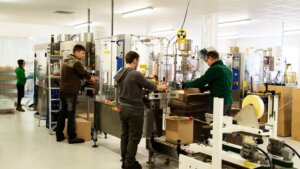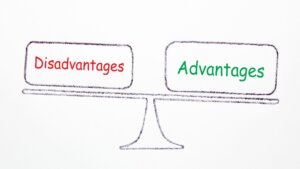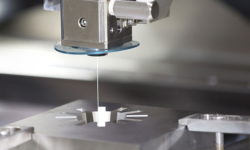Additive and subtractive manufacturing processes drive all global industries. All processes used in manufacturing fall into one of these two categories. Both come with their applications, advantages, and disadvantages. These factors are best understood by comparing additive manufacturing vs. subtractive manufacturing processes side by side.
Therefore, professionals often enquire about the details of each of these methods. Knowing their intricacies can help in choosing the right processes for the job. This saves time and resources and provides good-quality results.
This article will have a detailed comparison between additive and subtractive manufacturing processes. After reading the information presented here, you will be able to make an informed decision about which methods to choose.
What is the Main Difference Between Additive and Subtractive Manufacturing Processes?
Additive and subtractive manufacturing processes differ in their basic principle of operation. Additive manufacturing processes work by adding materials into the shape you require. On the other hand, subtractive manufacturing processes work by removing material from the workpiece. The material removal processes can use friction, erosion, heat, or sharp tooling.
Therefore, in additive manufacturing, you start with nothing and end up with the final part. However, in subtractive manufacturing, you start with a big piece of the workpiece and remove material to reach the final product.
Comparing Additive Manufacturing vs. Subtractive Manufacturing
Additive manufacturing and subtractive manufacturing differ in every parameter that matters. Let us study their performance in each of these parameters.
Material Wastage
Material wastage can be important when manufacturing precious metals or non-metal parts. Less amount of material wastage can reduce costs and benefit the environment.
- Additive Manufacturing: Additive manufacturing processes have minimal material wastage. These processes work on adding material instead of removing it.
- Subtractive manufacturing: Subtractive manufacturing processes have high material wastage. These processes chip away a lot of material to create the final product. In some cases, the removed material is non-recyclable.
Accuracy
Accuracy is important for projects that require consistency or secondary fitting. The tolerance of a manufacturing process determines accuracy. Higher tolerance means a lower accuracy and vice versa.
- Additive Manufacturing: Additive manufacturing processes generally have poor accuracy. This is because adding material isn’t as controlled as removing material. Additionally, the material expands uncontrollably on cooling, reducing accuracy further.
- Subtractive Manufacturing: Subtractive manufacturing processes are generally highly precise. This is because of the controlled machining processes and small cutting tools.
Supported Materials
Both additive and subtractive manufacturing processes cannot manufacture every material. Each of these processes has suitable materials they can work with.
- Additive Manufacturing: Additive manufacturing processes are limited in terms of material selection. They work on a few plastics and metals only. Materials like wood cannot undergo additive manufacturing processes.
- Subtractive Manufacturing: Subtractive manufacturing techniques work on all possible materials out there. Even materials like wood and glass can undergo many subtractive manufacturing techniques.
Manufacturing Complex Shapes
Many products have complex shapes and intricate geometries. Complex shapes fall out of the standard set of shapes like spheres, cubes, cuboids, etc.
- Additive Manufacturing: Additive manufacturing processes can create complex shapes. A mold of the complex shape is required to manufacture it with additive techniques.
- Subtractive Manufacturing: Subtractive manufacturing techniques can also manufacture complex parts. Due to the higher accuracy and multi-axis compatibility, subtractive manufacturing can create considerably more difficult shapes.
Manufacturing Closed Hollow Parts
Production Volume
A manufacturing process suitable for small-scale production might not be apt for large production runs. Additive and subtractive manufacturing processes have quite different performances in varying production runs.
- Additive Manufacturing: Additive manufacturing is ideal for parts required in smaller batches. This process requires molds for part creation. Additionally, there is a cooling stage to take into account.
- Subtractive Manufacturing: Subtractive manufacturing is better for large-volume batches. Multi-axis CNC machining can produce parts at a very high speed.
Manufacturing Speed
A higher manufacturing speed means a lower time taken to manufacture each part. This can provide a higher production volume in a given time.
- Additive Manufacturing: Additive manufacturing is slower than subtractive manufacturing. However, additive manufacturing can be the faster method for small parts in small volumes.
- Subtractive Manufacturing: Subtractive manufacturing is generally faster than additive manufacturing. However, the process can have some lead time, making it better for larger production runs. It is also faster when manufacturing bigger parts.
Surface Finishes
Surface finishing during manufacturing can eliminate the need for secondary finishing processes. This saves cost and time in the overall production time for parts.
- Additive Manufacturing: Additive manufacturing does not have options regarding surface finishes. The final finish can have a lot of surface imperfections. Therefore, secondary finishing is usually required.
- Subtractive Manufacturing: Subtractive manufacturing provides a smooth finish to the surface. Additionally, processes like CNC machining can give multiple finishing options.
Operator Skill
Processes requiring highly skilled operators can be tough or expensive to execute. Therefore, operator skill is important when comparing the two manufacturing techniques.
- Additive Manufacturing: Additive manufacturing does not require a highly skilled operator. This is because of the simple equipment and machinery used in additive manufacturing.
- Subtractive Manufacturing: Subtractive manufacturing processes utilize heavy machinery like CNC machining. Therefore, skilled operators are required.
Customization
Customization features are useful for manufacturers who work on prototyping processes or create tailored products. Customization is also useful for incorporating customer feedback into the products.
- Additive Manufacturing: Additive manufacturing processes do not provide any degree of customization. These processes use molds or models of the required part shape. For any customization, the mold has to be created again from scratch.
- Subtractive Manufacturing: Subtractive manufacturing processes have a high degree of customization. Simple modifications in the program can achieve any customization.
Safety
The safety of the manufacturing process is essential for the workforce. Focus on the manufacturing process’s safety protocol is crucial for beginners or inexperienced professionals.
- Additive Manufacturing: Additive manufacturing processes are relatively safer because they do not work with any sharp tools. However, they can release toxic fumes when working with plastics.
- Subtractive Manufacturing: Subtractive manufacturing processes require safety training due to the type of machinery. These machines have sharp tools that can easily pierce the body. Therefore, detailed safety instructions are required when operating this machinery.
What is Additive Manufacturing?
The additive manufacturing process means creating parts by depositing materials. The material is initially present as a filament, resin, or granules. It is heated and turned into the required part through various processes. Additive manufacturing is a simplified and straightforward manufacturing process.
Common Additive Manufacturing Techniques
There are many different additive manufacturing techniques in popular use. Some commonly used techniques are:
- 3D Printing
- Injection Molding
- Material Extrusion
- Powder Bed Fusion
- Direct Energy Deposition
- Binder Jetting
- Sheet Lamination
- Material Jetting
- VAT Polymerization
- Direct Metal Laser Sintering
- Stereolithography
- Electron Beam Melting
- Selective Laser Sintering
- Selective Laser Melting
- Fused Deposition Modeling
Advantages and Disadvantages of Additive Manufacturing
Additive manufacturing technologies can have many advantages and disadvantages associated with them. Let us go through each one by one:
Advantages
- Reduced Wastage: The primary benefit of these processes is that they lower material waste.
- Reduced Tooling: The cost of tooling for these processes is quite low.
- On-demand Production: This technique can meet on-demand production goals.
- Lead Times: The lead time in additive manufacturing is quite low.
- Sustainability: The lower material wastage makes additive manufacturing a sustainable process.
- Customization: Processes like 3D printing provide a good room for customization.
- Range of Materials: These processes support many different materials like metals, plastics, and ceramics. There are still many materials that they cannot use, like hardwood.
- Complex Parts: Additive manufacturing can create complex parts and internal features such as vents.
Disadvantages
- Surface Finishes: There are many surface defects on parts made with these processes. Secondary finishing is almost always required.
- Production Volume: These processes are not suitable for mass production.
- Quality Control: There is poor quality control and a lack of consistency.
- Material Limitation: There are a lot of materials that cannot undergo additive processes. Any material that doesn’t melt easily falls is hard to use with additive processes. Therefore, the material selection is mainly limited to thermoplastics and some metals.
When to Use Additive Manufacturing?
Additive manufacturing is a good fit for manufacturing small parts in small batches. It is also useful for making parts with internal geometry. For instance, additive manufacturing can create parts with cooling vents inbuilt. Additive manufacturing machines like 3D printing are good for small-size prototyping processes.
What is Subtractive Manufacturing Process?
The subtractive manufacturing process means manufacturing by removing material. It starts with a large chunk and removes material through controlled machining. The initial material can be a solid block, cylinder, sheet, or other shapes.
Common Subtractive Manufacturing Techniques
Several subtractive manufacturing technologies are used in different scales across the manufacturing sectors. Some common subtractive processes are:
- CNC Milling
- Turning
- Lathe
- Laser Cutting Tool
- Waterjet Cutting Tool
- Drilling
- Electrical Discharge Machining
- Grinding
- Reaming
Advantages and Disadvantages of Subtractive Manufacturing
Subtractive manufacturing is good at what it does. There can be minor disadvantages to the process as well. Let us discuss the pros and cons one by one:
Advantages of Subtractive Manufacturing
- High Accuracy: Subtractive manufacturing has very high precision. Any requirement where precision is important uses this technology.
- Computer Numerical Control (CNC): All subtractive processes can use computer numerical control. CNC automates the entire working process of the particular technology.
- Surface Finish: CNC machining leads to a highly smooth surface finish. Usually, the finished product does not require secondary finishing.
- Complexity: Subtractive manufacturing can create parts with very intricate designs. For instance, CNC machining can do wood carving.
- Speed: These techniques create parts at a very high speed. There is no need to wait for cooling since materials aren’t melted.
- Customization: Any changes in design can be made with small adjustments to the CAD software.
- Errors: CAD software simulation can also check the presence of errors in the designing or programming phase.
- Versatility: These techniques can work on any material regardless of its physical properties.
- Secondary Processing: These techniques do not require post-processing. It saves time and money.
- Modifications: Subtractive manufacturing can make modifications to an existing part. This can be helpful in case of repairs.
Disadvantages
- Wastage: The main disadvantage of these processes is waste generation. The wastage is amplified in large production runs.
- Cost: The cost of subtractive manufacturing equipment is considerably more than additive. Therefore, it is not preferred for small-volume production.
- Environmental Impact: High resource wastage can adversely affect the environment.
- Tool Wear: There is accelerated tool wear in subtractive manufacturing. This further increases wastage and costs.
- Safety: The sharp cutting tools of subtractive manufacturing processes can pose a safety hazard.
- Material Dust: This technique removes material that causes material dust in the workplace.
- Energy Consumption: These processes utilize heavy machining, which consumes a lot of electricity.
When to Use Subtractive Manufacturing?
Subtractive manufacturing is a great fit when precision and consistency are a concern. This includes sectors such as automotive and consumer electronics. In addition, components that require high finishing also use subtractive processes.
How to Decide Between Additive and Subtractive Manufacturing?
The choice between additive vs. subtractive manufacturing can be made by evaluating certain factors. These factors are:
- Type of Material: Consider the type of material your part requires. The material can make an easy decision between additive vs. subtractive manufacturing. For thermoplastics, additive manufacturing can be cost-saving. For metals and alloys, subtractive processes provide better results.
- Production Volume: Subtractive manufacturing is preferable for large production runs. Additive manufacturing is cost-saving for smaller batches.
- Sustainability: If the aim is to minimize wastage, additive manufacturing is better. If sustainability can be compromised for other factors, subtractive can provide better results.
- Accuracy: For high precision, go with subtractive manufacturing technologies.
- Operator Training: If you have a low-skilled workforce, additive processes can be easy. If training isn’t an issue, subtractive will work well.
- Cost: Additive processes are cost-saving for small parts in small batches. Subtractive processing provides the lowest cost for larger pieces and high volumes.
- Part Design: For parts with intricate designs, subtractive manufacturing can be a better choice. For parts with internal features like cooling vents, additive processing is the better option.
Cost of Additive vs Subtractive Manufacturing
There are many different costs associated with additive and subtractive manufacturing processes. Here is a breakdown of these costs:
- Equipment: Subtractive machines are considerably more costly than additive manufacturing machining. However, tooling costs are higher for additive processes than for subtractive ones.
- Material: The material costs are higher for additive processes. This is because additive technologies use specialized materials that can undergo heating.
- Secondary Processing: Secondary processing costs are higher for additive manufacturing. This is because the subtractive process can provide a smooth surface finish to the part.
- Labor: Both additive and subtractive processes come with automated controls. Therefore, the labor costs for each process are usually the same. An important point to note is that the automation capabilities of CNC are better than additive options. This is due to the ability of CNC to operate in multiple axes.
- Electricity: Both additive and subtractive manufacturing machines run on electricity. However, the electricity consumption of subtractive machines is higher. This leads to increased energy costs.
- Wastage Disposal: Subtractive processes have the added cost of waste disposal. Some of it can be recycled, but disposal costs are still attached.
Endnotes
Deciding between additive vs. subtractive manufacturing is not a clear-cut choice. Both of these technologies have their uses and shortcomings. Therefore, the choice of technology should be made based on the required application.
3ERP can help decide which technology between additive vs subtractive manufacturing would be a better option for your requirement. 3ERP provides on-demand manufacturing and prototyping services in each of these areas. The experts at 3ERp can also answer any queries you might have about additive vs. subtractive manufacturing processes.
Frequently Asked Questions
Here are the answers to some common questions regarding additive and subtractive manufacturing:
Is additive manufacturing better for the environment?
Yes, additive manufacturing is relatively better for the environment. This is because of the lower wastage caused by additive manufacturing processes.











